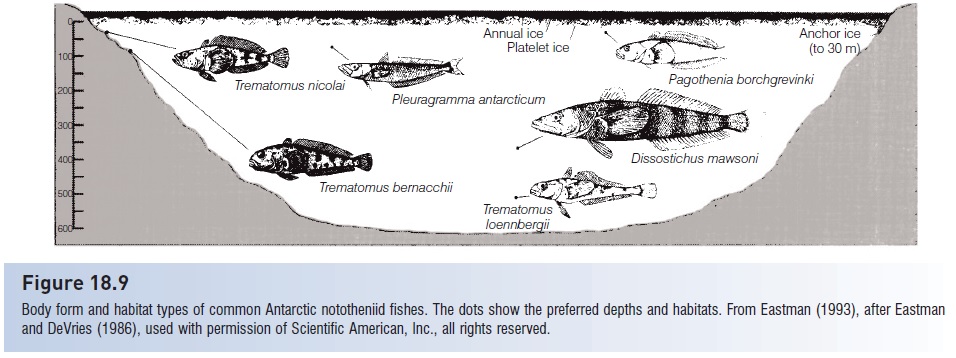Chapter: The Diversity of Fishes: Biology, Evolution, and Ecology: Special habitats and special adaptations
Antarctic fishes
Antarctic fishes
Antarctica is surrounded by at least 900 km of the open, deep Southern Ocean that flows around and away from the Antarctic continent. Strong circumpolar currents and distinct temperature differences occur between the polar and subpolar regions, delimited by a region known as the Antarctic Convergence at 50–60°S. This region creates a distance, depth, and thermal barrier to interchange between the cold-adapted species of the Antarctic region and warmadapted species to the north. Antarctic fishes have also had suffi cient time to adapt and speciate; the Antarctic region has been at its present locale with its present climate for about 20–25 million years, having separated from Australia during the Early Cenozoic (Hubold 1991; Eastman 1993). Spatial and temporal seclusion and climatic extremes have resulted in a diverse fish fauna dominated by endemic notothenioid thornfishes, cod icefishes, channichthyid crocodile icefishes, plunderfishes, and dragonfishes, as well as several non-notothenioid groups (Farrell & Steffensen 2005; Fukuchi et al. 2006; Marine zoogeographic regions).
Notothenioids as a group are benthic fishes and fully half of all species still live on the bottom in less than 1000 m of water (Fig. 18.9). As is general among benthic fishes, they lack gas bladders, are dark in coloration, and are

Figure 18.9
Body form and habitat types of common Antarctic nototheniid fishes. The dots show the preferred depths and habitats. From Eastman (1993), after Eastman and DeVries (1986), used with permission of Scientific American, Inc., all rights reserved.
Benthic forms often seek cover inside sponges, either as a refuge from predatory mammals or as a spawning substrate. Eggs placed inside hard sponges such as hexactinellid glass sponges are probably protected from most predators (Dayton et al. 1974; Konecki & Targett 1989). Larvae are pelagic and show adaptations specific to shallow, open water existence, including silvery coloration, relatively compressed bodies, and forked tails (see above, The open sea). Notothenioids have also radiated into most nonbenthic niches and consequently show substantial variation in body form and behavioral tactics, starting with a common body plan.
A few species, including the abundant Cod Icefish, Pleuragramma antarcticum, are pelagic zooplanktivores. Socalled cryopelagic fishes live in open water just below the ice. The food chain for these fishes starts with ice algae, which is eaten by amphipods and euphausiids, which are in turn eaten by the fishes. Cryopelagic fishes have a uniform light coloration that may help them blend in with the icy background against which they would be viewed. They also possess better chemical defenses against freezing and have greater buoyancy than benthic relatives.
Notothenioids are interesting reproductively because they produce a small number of relatively large, 2–5 mm eggs during a short, 1–2-month spawning season. The unhatched larvae have developmental periods of 2–6 months, followed by a long, slow-growing pelagic stage that lasts a few months to 1 year. Many benthic species exhibit parental and biparental guarding (Daniels 1979; Kellerman & North 1994). Notothenioids are opportunistic feeders, taking a wide range of prey types, with many pelagic and mesopelagic juveniles and adults feeding on the ubiquitous krill, Euphausia superba, that is also the major prey of whales, penguins, and other seabirds. Although the annual temperature variation in Antarctica is seldom more than 4°C (–2° to +2°C), and in some locales as little as 0.1°C, fishes show marked variation in summer versus winter feeding rates. Rates are still relatively high during winter (e.g., 65% of summertime intake in Harpagifer antarcticus; Targett et al. 1987), unlike temperate locales where many fishes cease feeding in winter.
Mesopelagic fishes are particularly abundant throughout the water column of the Southern Ocean. Lanternfishes are the most diverse group of mesopelagic fishes at lower latitudes, but are epipelagic in the Antarctic. The lanternfish Electrona antarctica is the most common fish above 200 m. It feeds heavily during the day, in contrast with the typical mesopelagic pattern of nocturnal foraging that characterizes lanternfishes at lower latitudes. “Mesopelagic” species are also an important component of the community living near the ice edges or “oceanic marginal ice zone”. Large numbers of myctophid lanternfishes are eaten in the open sea and at the edge of the pack ice by seabirds, whales, and seals. A commercial midwater trawl fishery even exists for mesopelagic species, with annual catches of the lanternfish Electrona carlsbergi exceeding 78,000 tons (>70 x106 kg) from the South Georgia Island region. As with their more northerly, low-latitude relatives, deep-living mesopelagic fishes in the Antarctic show lower enzyme activity and slower metabolic rates than shallow water forms, which is interpreted as an adaptation to low food availability at depth (Kellerman & North 1994; see above, The deep sea).
Harpagiferid plunderfishes, which are advanced perciform fishes, are remarkably similar in morphology and behavior to the relatively primitive scorpaeniform sculpins of northern temperate waters. Similarities may represent adaptations to a predominantly benthic existence, including a relatively depressed, elongate, tapering body; large, spiny head with large eyes and a large, terminal mouth; long dorsal and anal fins; large pectoral fins; rounded caudal fin; and a dorsally located lateral line. Both groups show ecological and behavioral similarities as well, feeding by a sit-and-wait mode on relatively large, mobile benthic invertebrates. In essence, plunderfishes and sculpins have converged to fill similar niches in their respective communities (Wyanski & Targett 1981).
Related Topics